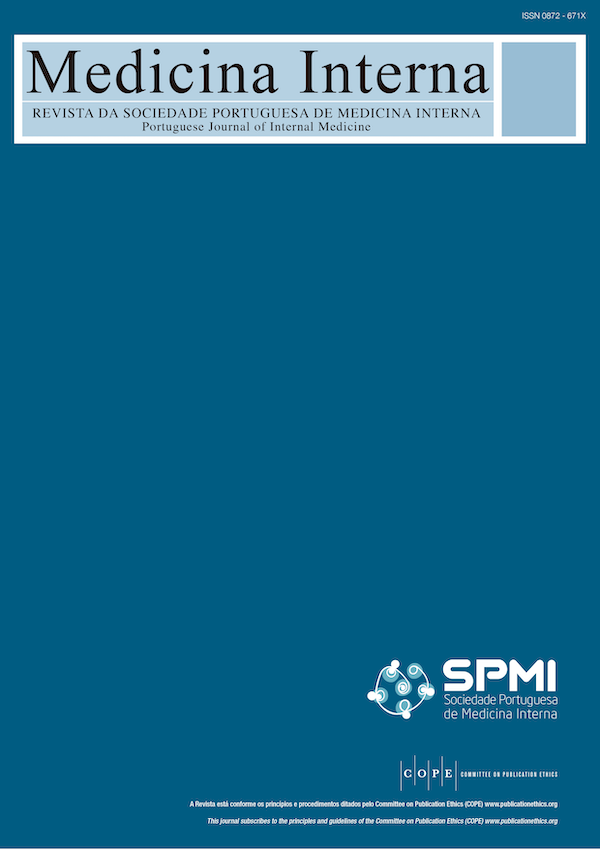Sclerosing Encapsulating Peritonitis: A Rare and Insidious but Potentially Fatal Disease
DOI:
https://doi.org/10.24950/CC/302/20/2/2021Keywords:
Peritoneal Dialysis/adverse effects, Peritonitis, SclerosisAbstract
Sclerosing encapsulating peritonitis is a rare and insidious disease associated with peritoneal thickening and fibrosis and it mainly affects patients with history of peritoneal dialysis. Unfavourable clinical outcomes with bowel incarceration are common, with a mortality rate of 25%- 55%. We report a case of a 47-year-old man with chronic kidney disease and previous peritoneal dialysis who was assisted in the emergency department with fever, anorexia and one-week evolution ascites. Increased inflammatory acute phase markers was documented. Radiological evaluation showed a septate ascites, peritoneal thickening and bowel obstruction. Ascitic fluid was suggestive of hematic exudative ascites. Tamoxifen and steroids were started with significant clinical and radiological improvement. Here we describe a rare and potentially fatal complication of peritoneal dialysis. Due to its unspecific symptoms and clinical presentation meticulous clinical examination is required in suspected cases.
Downloads
References
Salzer WL. Peritoneal dialysis-related peritonitis: challenges and solutions. Int J Nephrol Renovasc Dis. 2018;11:173–86. doi: 10.2147/IJNRD. S123618
Kosmadakis G, Albaret J, da Costa Correia E, Somda F, Aguilera D. Gastrointestinal Disorders in Peritoneal Dialysis Patients. Am J Nephrol. 2018;48:319–25. doi: 10.1159/000494145
Raina R, Schreiber MJ, Gebreselassie S. Chronic abdominal pain in a patient on maintenance peritoneal dialysis. Adv Perit Dial. 2011;27:87-9.
Lew SQ. Hydrothorax: Pleural Effusion Associated with Peritoneal Dialysis. Perit Dial Int. 2010;30:13–8. doi: 10.3747/pdi.2008.00168.
Hamad A, Hussain ME, Elsanousi S, Ahmed H, Navalta L, Lonappan V, et al. Prevalence and Management of Hypokalemia in Peritoneal Dialysis Patients in Qatar. Int J Nephrol. 2019;18;2019:1–6. doi: 10.1155/2019/1875358
Li G, Zhang L, Ren H, Huang B, Mao C, Zhou A. Clearance of magnesium in peritoneal dialysis patients: a single-center study. Blood Purif. 2019;47:1–7. doi: 10.1159/000496217.
Balda S, Power A, Papalois V, Brown E. Impact of hernias on peritoneal dialysis technique survival and residual renal function. Perit Dial Int.
;33:629–34. doi: 10.3747/pdi.2012.00255
Yang SF, Liu CJ, Yang WC, Chang CF, Yang CY, Li SY, et al. The Risk Factors and the Impact of Hernia Development on Technique Survival in Peritoneal Dialysis Patients: A Population-Based Cohort Study. Perit Dial Int. 2015;35:351–9. doi: 10.3747/pdi.2013.00139.
Lew SQ. Hemoperitoneum: Bloody Peritoneal Dialysate in Esrd Patients Receiving Peritoneal Dialysis. Perit Dial Int. 2007;27:226–33. doi:
1177/089686080702700303
Nakamoto H. Encapsulating peritoneal sclerosis--a clinician´s approach to diagnosis and medical treatment. Perit Dial Int. 2005;25:S30-S38.
Gandhi VC. Sclerotic thickening of the peritoneal membrane in maintenance peritoneal dialysis patients. Arch Intern Med. 1980;140:1201. doi: 10.1001/archinte.1980.00330200077024.
Hong K-D, Bae JH, Jang Y-J, Jung H-Y, Cho J-H, Choi J-Y, et al. Encapsulating peritoneal sclerosis: case series from a university center. Korean J
Intern Med. 2013;28:587. doi: 10.3904/kjim.2013.28.5.587.
Moinuddin Z, Summers A, Van Dellen D, Augustine T, Herrick SE. Encapsulating peritoneal sclerosing – a rare but devastating peritoneal disease. Front Physiol. 2015;5. doi: 10.3389/fphys.2014.00470.
Kawaguchi Y, Kawanishi H, Mujais S, Topley N, Oreopoulos DG. Encapsulating peritoneal sclerosis: definition, etiology, diagnosis, and treatment. International Society for Peritoneal Dialysis Ad Hoc Committee on Ultrafiltration Management in Peritoneal Dialysis. Perit Dial Int. 2000;20:S43-S55.
Spence R, Gillespie S, Loughrey M, Gardiner K, Encapsulating Peritoneal Sclerosis – A 5 Year Experience Ulster Med J. 2013;82:11-5
Vlijm A, Stoker J, Bipat S, Spijkerboer AM, Phoa SSKS, Maes R, et al. Computed tomographic findings characteristic for encapsulating peritoneal sclerosis: a case-control study. Perit Dial Int. 2009;29:517–22. doi: 10.1177/089686080902900508.
Guest S. Tamoxifen therapy for encapsulating peritoneal sclerosis: mechanism of action and update on clinical experiences. Perit Dial Int.
;29:252–5. doi: 10.1177/089686080902900304.
Korte MR, Fieren MW, Sampimon DE, Lingsma HF, Weimar W, Betjes MG, et al. Tamoxifen is associated with lower mortality of encapsulating peritoneal sclerosis: results of the Dutch Multicentre EPS Study. Nephrol Dial Transpl. 2010;26:691–7. doi: 10.1093/ndt/gfq362.
Loureiro J, Sandoval P, del Peso G, Gónzalez-Mateo G, Fernández-Millara V, Santamaria B, et al. Tamoxifen Ameliorates Peritoneal Membrane Damage by Blocking Mesothelial to Mesenchymal Transition in Peritoneal Dialysis. PLoS One. 2013;8:e61165. doi: 10.1371/journal.pone.0061165.
Kawanishi H, Kawaguchi Y, Fukui H, Hara S, Imada A, Kubo H, et al. Encapsulating peritoneal sclerosis in Japan: A prospective, controlled,
multicenter study. Am J Kidney Dis. 2004;44:729–37. doi: 10.1016/S0272-6386(04)00953-9.
Kolesnyk I, Dekker FW, Noordzij M, le Cessie S, Struijk DG, Krediet RT. Impact of ACE inhibitors and aii receptor blockers on peritoneal membrane transport characteristics in long-term peritoneal dialysis Patients. Perit Dial Int. 2007;27:446–53. doi: 10.1177/089686080702700413
Downloads
Published
How to Cite
Issue
Section
License

This work is licensed under a Creative Commons Attribution 4.0 International License.
Copyright (c) 2023 Medicina Interna






